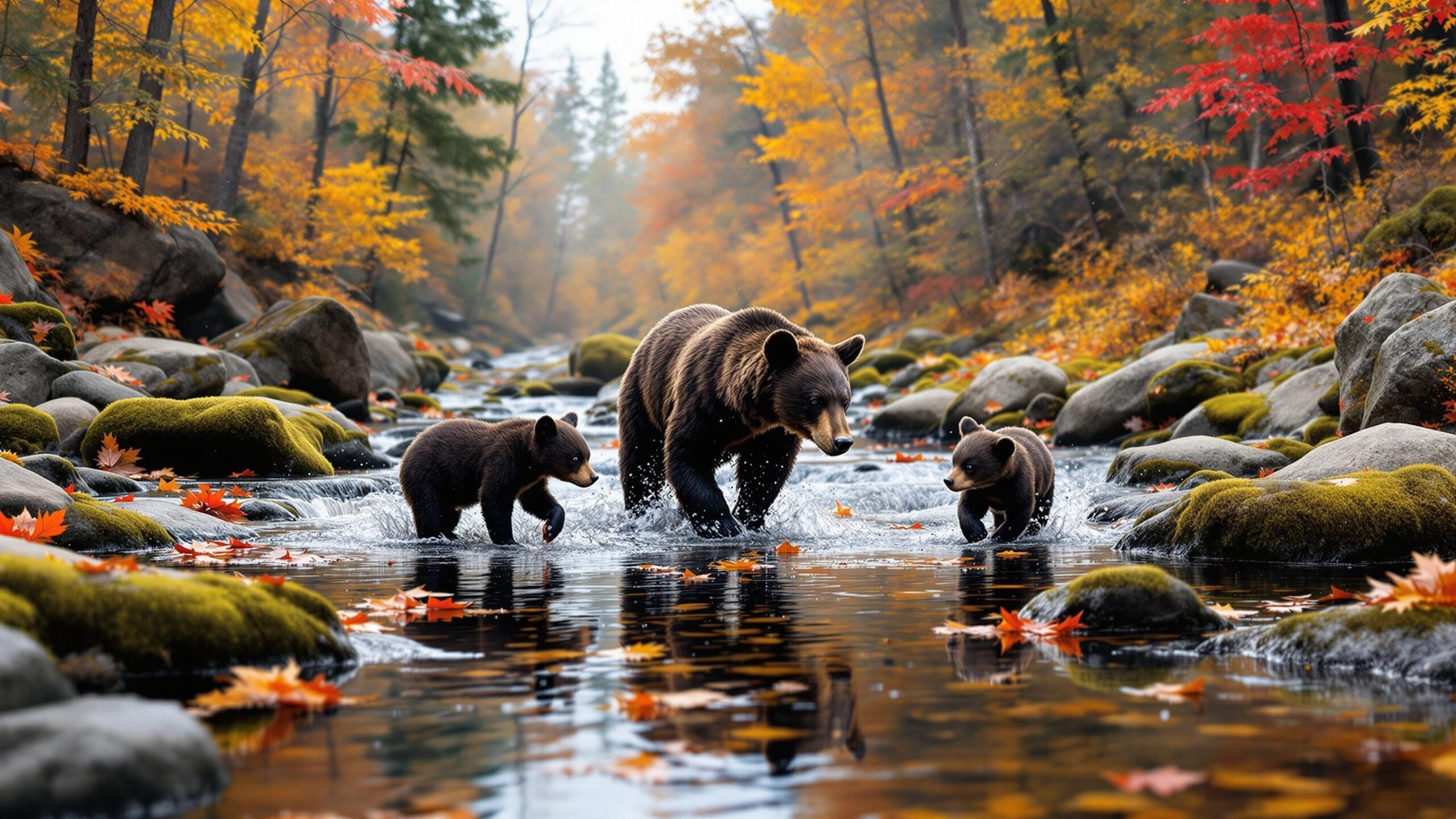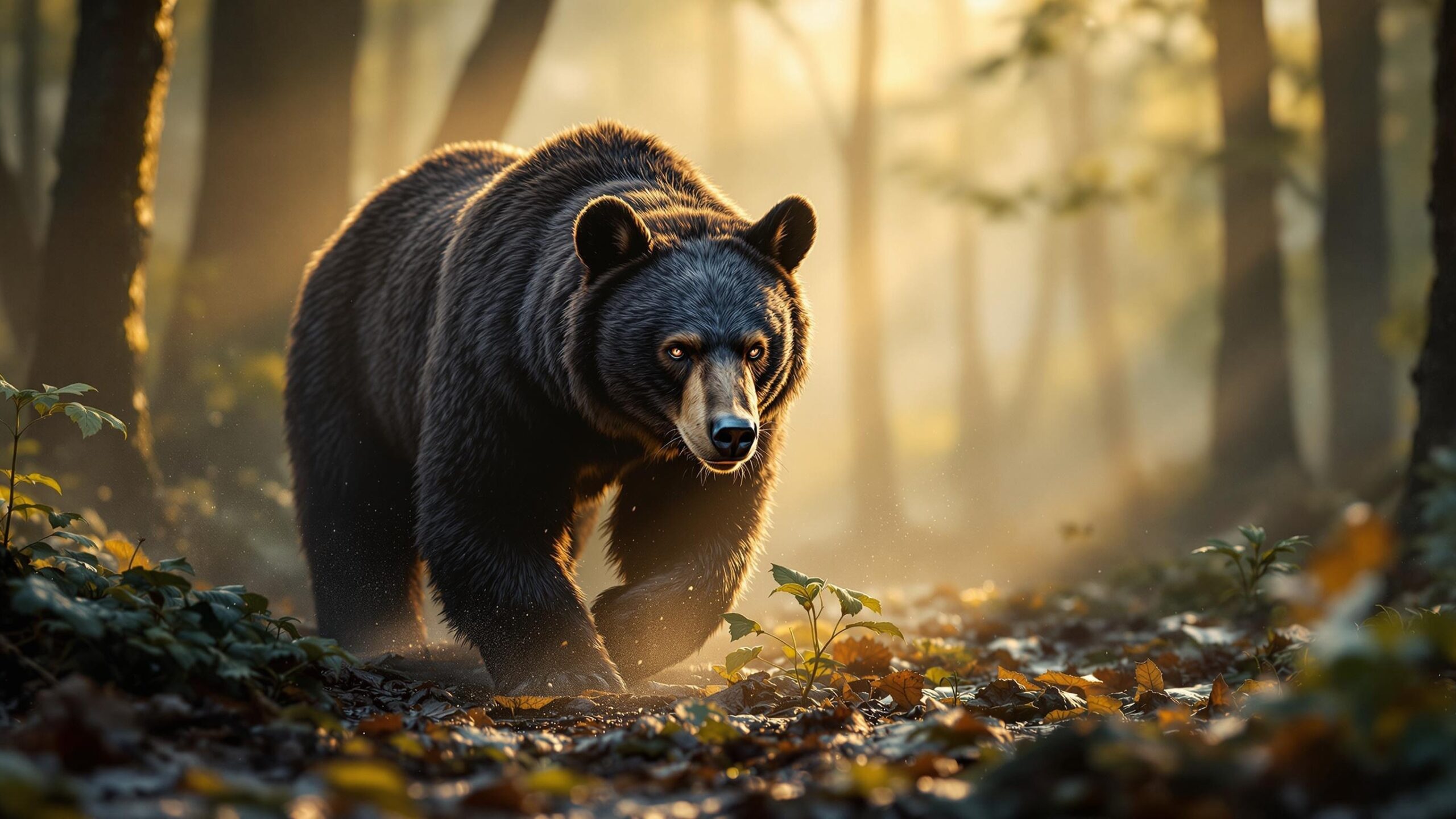Eastern Black Bear (Ursus americanus): A Majestic Symbol of North America’s Wild Woodlands
The Eastern Black Bear (Ursus americanus) stands as one of North America’s most iconic and adaptable wildlife species. Recognized for its strength, intelligence, and secretive nature, this formidable mammal thrives in a wide range of forested environments, from the Appalachian Mountains to the remote woodlands of Eastern Canada. As the most widespread bear species on the continent, the Eastern Black Bear represents a crucial part of forest ecosystems and has long fascinated humans with its presence, power, and personality. This article offers a complete guide to the Eastern Black Bear, exploring its physical features, behaviors, diet, reproductive cycle, habitat range, human interactions, and conservation considerations. With a blend of science, storytelling, and accessible insight, this profile is ideal for wildlife enthusiasts, students, and nature lovers alike.
Physical Description: Built for Survival
Despite its name, the Eastern Black Bear is not always black. While black is the predominant color in the eastern populations, individuals can also be brown, cinnamon, or even blonde in rare cases. Their fur is dense and oily, providing excellent insulation and protection from both cold and rain. Most Eastern Black Bears have a straight facial profile with small, rounded ears and a short, non-prominent tail.
A patch of white fur may be present on the chest, though this varies among individuals. Adult males typically weigh between 200 to 600 pounds, while females range from 100 to 300 pounds. In exceptional cases, males can exceed 600 pounds, particularly when food sources are abundant. Standing on all fours, they measure between 2.5 and 3 feet at the shoulder, and when upright, they can reach heights of up to 7 feet. Despite their hefty build, black bears are agile climbers and surprisingly fast runners, capable of reaching speeds up to 30 miles per hour.
Range and Habitat: From Northern Forests to Appalachian Hills
The Eastern Black Bear occupies a diverse range of habitats across eastern North America. Its distribution extends from the Canadian provinces of Ontario, Quebec, and New Brunswick down through the northeastern United States, the Great Lakes region, and the Appalachian Mountains into the southeastern U.S.
These bears are habitat generalists, meaning they can thrive in a variety of forested environments, including deciduous, coniferous, and mixed forests. They prefer areas with dense understory vegetation for cover, access to water sources like streams or wetlands, and availability of mast-producing trees such as oaks and beeches. In more developed landscapes, they may also utilize fragmented habitats, adapting to suburban edges and agricultural zones, although such encroachments can lead to increased human-bear conflicts.
Behavior and Daily Life: Solitary, Strategic, and Seasonal
Eastern Black Bears are primarily solitary animals, with the exception of mothers with cubs or during the brief breeding season. They are crepuscular, meaning they are most active during dawn and dusk, although activity patterns may shift depending on human presence, food availability, and season. Highly intelligent and curious, black bears use their keen sense of smell—seven times stronger than a bloodhound’s—to locate food. Their behavior is largely dictated by seasonal changes. In spring and summer, they forage extensively to rebuild fat reserves lost during winter dormancy. By fall, bears enter a phase known as hyperphagia, during which they consume up to 20,000 calories per day in preparation for winter hibernation. In colder climates, Eastern Black Bears hibernate in dens made in hollow trees, caves, or brush piles. During hibernation, their metabolic rate slows drastically. Remarkably, they do not eat, drink, urinate, or defecate during this time, relying entirely on fat stores to sustain them. Contrary to popular belief, black bears can be roused during hibernation and may leave their dens temporarily if disturbed.
Diet: Omnivorous Opportunists
The Eastern Black Bear’s diet is highly varied and primarily vegetarian, though opportunistically omnivorous. In spring, they eat emerging vegetation, buds, and young shoots. Summer brings a bounty of berries, fruits, and insects like ants and grubs. In autumn, they shift to calorie-dense foods like acorns, beechnuts, and other nuts to prepare for hibernation. While plant matter makes up the bulk of their diet, they will also consume small mammals, bird eggs, carrion, and occasionally newborn fawns or livestock. Black bears are also known to raid beehives, agricultural fields, and garbage containers when natural food sources are scarce or human settlements encroach on their range. Their adaptability in diet is one of the primary reasons for their ecological success.

Reproduction and Life Cycle: A Slow but Strategic Rhythm
Mating season for Eastern Black Bears typically occurs from May to July. Males travel extensively in search of receptive females, and mating is often brief. Interestingly, black bears exhibit a phenomenon known as delayed implantation. After fertilization, the embryo does not immediately implant in the uterine wall. Instead, it remains dormant until fall. This allows the mother to assess her body condition before committing to pregnancy.
If her fat reserves are sufficient by the time she enters the den, the embryo implants and continues development. Cubs are born in mid-winter, usually January or February, while the mother is hibernating. Litters typically consist of one to three cubs, though four or more are possible in food-rich environments. Cubs are born blind, hairless, and weighing less than a pound. They nurse in the den and grow rapidly, emerging with their mother in spring. They remain with her for about 16 to 18 months, during which she teaches them vital survival skills. After weaning, the cubs set out to establish their own territories, often traveling considerable distances. Females reach sexual maturity around three years of age, while males may take slightly longer to establish reproductive success due to competition.
Communication and Senses: More Than Meets the Eye
Eastern Black Bears rely on a variety of sensory and behavioral cues to communicate. Scent marking plays a major role in conveying territorial boundaries and reproductive status. Bears often rub against trees, claw bark, or leave scat in strategic locations to signal their presence.
Vocalizations are typically reserved for close-range communication. Cubs emit high-pitched squeals and grunts to express distress or contentment, while mothers produce low grunts to maintain contact. Adults may huff, click their teeth, or make popping sounds with their jaws when agitated or threatened. Their hearing and vision are both strong, but it’s their sense of smell that stands out. They can detect odors from over a mile away, which helps them locate food, mates, and other bears across vast forested landscapes.
Interactions with Humans: Caution, Curiosity, and Coexistence
Human-bear interactions have become increasingly common as development expands into traditional bear habitats. Most encounters are harmless, with bears retreating at the first sign of human activity. However, food-conditioned bears—those that have learned to associate humans with food—can become bold, leading to property damage and potential danger.
To minimize conflict, wildlife agencies emphasize bear-wise practices such as securing garbage, removing bird feeders, and storing pet food indoors. Campers and hikers are encouraged to use bear-proof containers and practice proper food storage. In some regions, black bear populations are managed through regulated hunting and relocation programs. These measures aim to reduce conflicts and maintain sustainable bear densities. While the vast majority of black bears are not aggressive, it’s vital to treat them with respect and caution, recognizing their wild nature.
Cultural and Ecological Significance: A Creature of Legend and Landscape
The Eastern Black Bear holds a special place in Indigenous cultures and North American folklore. Many Native American tribes regard the bear as a symbol of strength, introspection, and healing. Bear imagery appears in stories, ceremonial practices, and totems across the continent. Ecologically, black bears play an important role in forest dynamics. By consuming fruit and dispersing seeds through their scat, they help maintain plant diversity. Their digging and foraging behaviors also aerate soil and influence insect populations. As apex omnivores, they help regulate smaller animal populations and contribute to the overall balance of their ecosystems.
Conservation Status: Thriving, but Not Without Challenges
The Eastern Black Bear is currently listed as a species of “Least Concern” by the International Union for Conservation of Nature (IUCN), thanks to its wide distribution and robust population numbers in many regions. However, localized declines and threats still exist. Habitat loss due to logging, development, and road construction poses an ongoing risk. Vehicle collisions are a significant source of mortality, particularly in areas where road networks fragment bear territory. Climate change may also impact food availability and denning behavior in the long term. Conservation strategies often focus on habitat protection, public education, and responsible wildlife management. Initiatives such as wildlife corridors, protected forest areas, and community awareness campaigns are helping to ensure the continued success of black bear populations.

Bear Watching and Ecotourism: A Window into the Wild
Seeing an Eastern Black Bear in the wild is a thrilling experience for many nature enthusiasts. The best chances for observation occur in large forest preserves, national parks, and remote wilderness areas, especially during the spring and fall when bears are more active and visible. Ecotourism centered around bear viewing has grown in popularity in parts of the United States and Canada. These experiences not only foster appreciation for wildlife but also support local economies and conservation efforts. Guides and wildlife photographers emphasize ethical viewing practices, such as maintaining a safe distance and not feeding bears.
Fascinating Facts: Highlights from the Eastern Black Bear’s World
The Eastern Black Bear has many surprising qualities. For instance, their heart rate during hibernation can drop from 40–50 beats per minute to just 8. They can go for over 100 days without food or water, yet emerge healthy and alert in spring. Despite their reputation, black bears are not true hibernators. Their body temperature remains relatively high compared to other hibernating mammals, and they can awaken quickly if disturbed. Their memory and spatial awareness rival those of primates, allowing them to remember food sources and navigate complex landscapes with remarkable accuracy.
Guardians of the Forest
The Eastern Black Bear is far more than a shadowy figure slipping through the trees. It is a powerful symbol of wilderness, a keystone species, and a living testament to the resilience of North America’s wild places. As we learn more about their behavior, biology, and interactions with our world, we also discover the importance of coexistence and stewardship. Through education, habitat conservation, and thoughtful management, we can ensure that the Eastern Black Bear continues to roam the forests for generations to come—reminding us that true wildness still thrives at the edge of our awareness.

